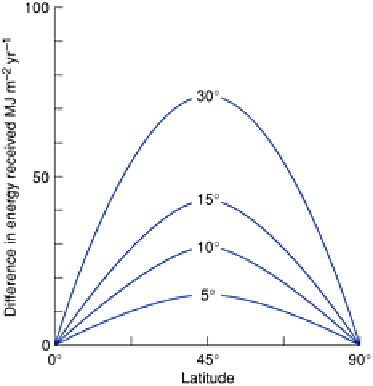Environmental Engineering Reference
In-Depth Information
Figure 26.11
The effect of aspect on solar radiation received
at the ground surface, and the secondary effects of slope
angle.
surrounding horizon. These parameters can be used either in nomograms or in computer
programs to calculate total annual and daily incoming radiation, including shading
effects. This calculation allows a long list of ecologically important variables to be
estimated: potential evapotranspiration, actual evapotranspiration, gross productivity, soil
moisture content. The control of incoming radiation on plant communities is broadly
viewed as the dual effect of temperature and moisture: a direct temperature effect on the
plant via ambient temperature and biochemical reaction rates, and an indirect effect on
the soil water content via evaporation and transpiration rates. The two effects are well
integrated in the real world and it is often difficult to disentangle them. However,
research indicates that temperature has a greater influence on floristics (i.e. the plant
species on different aspects), whilst soil moisture governs biomass of vegetation and
percentage cover (i.e. the productivity of the plant community).
The terms 'patchwork' and 'mosaic' are frequently used to describe the distribution of
Mediterranean vegetation. In terms of the diversity concepts introduced in Chapter 23,
this is reflected in the beta diversities which occur along topographic transects in the
region. Figure 26.12 shows the results of several years of research in southern France.
The alpha diversity is shown by S, the number of species, and the beta diversity by the B
values. Here slope and land use combine to give a diverse landscape.

